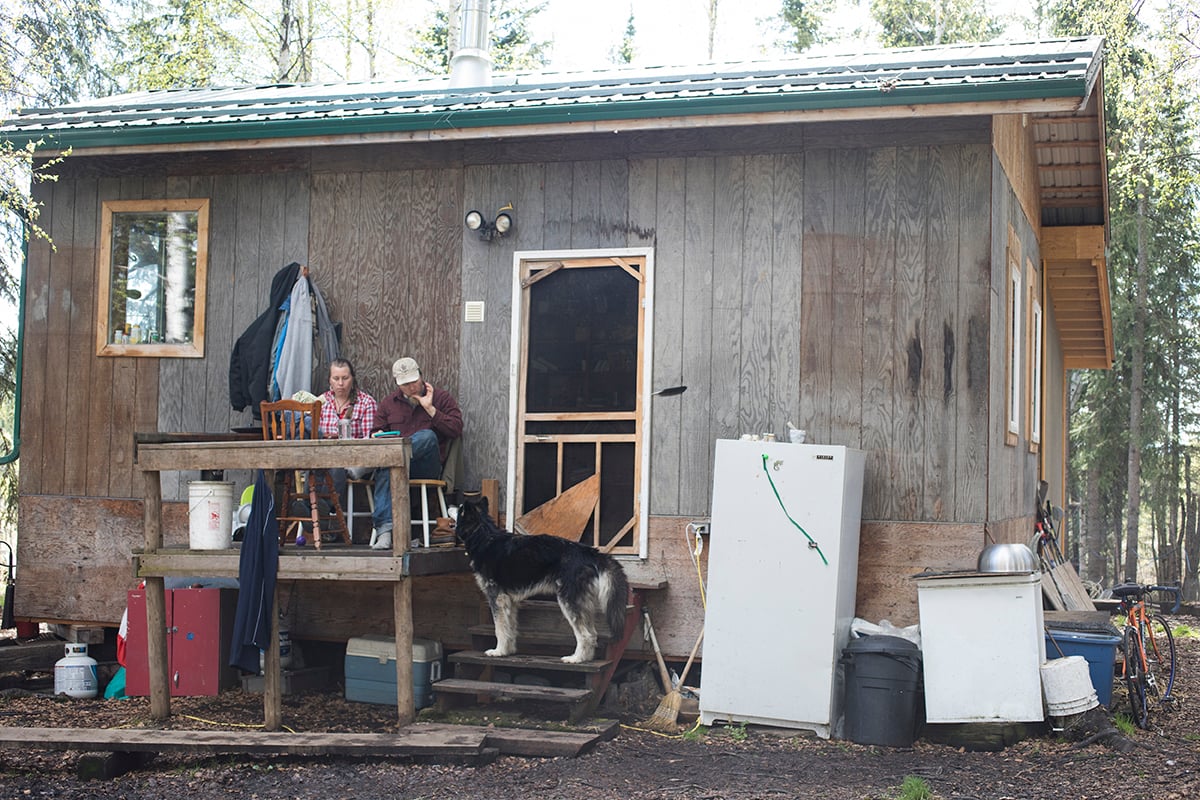Roughing It: How the ‘Last Alaskans’ Live Off the Grid and Hunt for Their Food

“Well, you city folk don’t know anything.”
I’m interviewing Tyler Selden, and things aren’t going so great.
Maybe it’s because he and his wife Ashley spend eight months a year in a remote corner of Alaska and aren’t used to being pestered with questions.
But, no, that can’t be true…
Because, for several years, they’ve starred in a television show called “The Last Alaskans.” And anyone who can handle a camera in their faces can probably handle a phone interview.
So maybe Tyler thinks I won’t understand his lifestyle — one that’s starkly different from mine, and from most Americans.
But as we continue to talk, Tyler warms up. He tells me about his trapline, his sled dogs and his family, about the perils — and thrills — of being alone in the wilderness.
He tells me he’d rather die than have a traditional job. He tells me things work out when you pursue your dreams.
He tells me his story.
Tyler, 35, hails from Nebraska, and Ashley, 33, from Minnesota. They met in college in Duluth.
During their summer break in 2005, Tyler took a restaurant job in Denali National Park. On his days off, he explored the surrounding wilderness — and was blown away by what he saw.
“I was really sick of school,” he explains. “I felt like I wasn’t doing what I was meant to do.” So he decided to follow his “pipe dream” — to move to Alaska and live off the land.
“I really value having a direct connection with nature,” says Tyler. “I don’t get as much satisfaction from the idea of having a job or a career.”
Not wanting to end their relationship, Ashley decided to drop out, too. The following March, they moved to Alaska to begin their new life.
Living With the Land

Tyler taught himself to trap animals, and they soon built an off-the-grid cabin above the Arctic Circle.
Together they established their winter trapline:
They built a main cabin and other shelters, cut trails and acquainted themselves with the harsh environment.
“Your job while you’re up there is to maintain those trails,” says Tyler. “They’re like your arteries into the wilderness. You have to go out there to catch your fur by setting and maintaining your traps.”
Now, every year between August and March or April, they live in the cabin, travel via dog sled and eat the food they grew or caught. For money, they trap animals like Canadian lynx, wolves, wolverines, martens, fox and beavers.
“You target whatever’s abundant,” says Tyler. “We trap ‘em, skin ‘em, put ‘em up, dry ‘em out and feed the carcasses to our dogs or ourselves. We keep the skulls and everything; we make as much money off an animal as we can.”

When back in Fairbanks for the summer, they sell the furs to small buyers and dealers, or to people interested in making crafts or wall hangers.
On average, here’s how much they earn per animal:
- Fox: $50
- Marten: $90-$100
- Lynx: $150-$200
- Wolverines and wolves: $300-$500
The couple’s goal is to make enough money to cover their expenses, which run about $10,000 per season (mostly due to charter flights in and out of their isolated location).
“It’s not a money-making thing,” notes Tyler. “It’s a lifestyle.”
The Discovery Channel Steps In

For their first several years in Alaska the Seldens maintained steady construction jobs in Fairbanks. “We would work as hard as we could all summer so we could go blow it on the trapline,” says Tyler.
But in 2014, everything changed.
The Animal Planet approached the Seldens, asking to film their winter trapping activities for a new show. The network promised the couple wouldn’t have to do anything differently; they’d just have to allow a camera around sometimes. So they went for it.
“It’s a way to continue to live out there,” says Tyler. “If we could not do it, we would, but it’s money. We were busting our ass and killing ourselves trying to make ends meet.”
The show, which eventually switched to the Discovery Channel, has brought the Seldens into millions of homes across the nation.
Though the Seldens’ bank account has a little more padding these days, their lifestyle hasn’t changed much.
During the summer in Fairbanks, they live in a dry cabin — which means they have electricity but no running water. They use rain water for dishes and cleaning, and drinking water is delivered or hauled in buckets from a nearby spring. They also have a greenhouse and large garden.

They have paid off all their debt and lead an extremely frugal lifestyle. Their only major expenses are firewood, gas and car insurance, and caring for eight sled dogs.
They get their clothes and most of their shoes for free from a waste transfer site and use chicken droppings for compost.
“I feel like our spending habits are so ingrained, so normalized to me,” Tyler says. “So much of what we do, it’s just a habit. Every way we can, we just try to save money. We’re always scrounging.
If the couple has extra money, they invest it back into their properties or trapline. They recently purchased an adjoining property in Fairbanks, which they rent out on Airbnb.
They don’t, however, have any money saved for retirement. “I’m not working toward retirement,” explains Tyler. “I have no intention of ever retiring.”
At the point he can no longer work, he hopes he and Ashley will have their lifestyle so “dialed in” that they won’t need much money.
Working for Their Food

One huge money-saver: They catch or grow around 75% of their food.
“Our lives in large part kind of revolve around food,” says Tyler. “I think most people’s lives do — they just don’t realize it. Because you’re working to make money so you can buy food and whatever else you need. We just work for that stuff directly.”
Most of their store-bought food includes staples like flour, rice, oatmeal, nuts and beans, and some “things to make life nice,” like chocolate and sugar.
The rest comes from their summer garden — which has a bounty of vegetables and herbs like kale, cabbage, carrots, onions, beets, tomatoes, peppers, sage, rosemary and thyme — and their hunting and fishing efforts.
“We kill a moose every fall, we snare rabbits, we shoot grouse, we catch fish, we catch animals in traps — primarily lynx,” says Tyler. “We feed our dog team with fish that we catch in the river right by our house.”
They estimate this lifestyle saves them approximately $10,000 per year. Think: a thousand pounds of moose meat, freshly-caught Alaskan salmon, other critters and a season’s worth of organic vegetables and herbs.
“If you were to actually pay on the market what this stuff is really worth, it’d be astronomical,” says Tyler. “No one would eat that way because it’d be really expensive. We have a high quality of life here because we put a lot of effort in obtaining good, quality food.”
“If you spend time doing that,” adds Ashley, “you can’t afford to work normally or have a career like some people do.”

And going back to a normal career isn’t something either of them plan to do.
“Trying to go back to that would be like trying to break a wild horse in,” Ashley says. “We’re shaped this way… and we’re so much more involved with the things we need out of life than to just go trade all of our time for some groceries at Fred Meyer and home decor and who knows whatever else people spend their money on but shouldn’t.”
Tyler agrees, saying, “I’m addicted to living this way — the wilderness, the freedom of it. Just being my own boss, being my own man and going out there and being alone with my family. This is what I’m gonna do until I can’t do it anymore. It’s who I am now.”
And now that they’ve recently introduced a daughter, Sydney, into the world, they’re even more entrenched in their desire to spend time together — and not at a traditional job.
“I would pick the poor house,” says Ashley. “I would pick eating at the food bank before I’d go get a job and not raise my own kid.”
But the Wilderness Can Bite Back

A few winters ago, the Seldens were up north on their trapline. They mushed all day to get to one of their shelters, but when they got there, the river wasn’t frozen over and they couldn’t cross it. They were stuck. Night was quickly approaching. They had sleeping bags, but no food — and no other choice but to camp there for the night.
While these moments of self-sufficiency are scary, they’re also what make the Seldens feel alive.
“You’re in the middle of the last great wilderness,” says Tyler. “You’re the king of your own little kingdom. You’re totally isolated and have to figure everything for yourself. It’s total freedom.”
“It’s easy to go back home to the steamy shower and the big screen,” says Ashley. “It’s such a nice feeling to be really connected to the world, and to notice it. To notice all the little things.”
According to the Seldens, you don’t have to move to Alaska or live off moose meat to find that connection. You just have to be willing to try something different.
“Happiness is elsewhere — off on the side trails of life,” explains Tyler. “We’re not anything special; we just aren’t afraid of hard work and aren’t afraid to try something and fail.”
Susan Shain is a freelance writer and digital nomad. She covers travel, food and personal finance (basically, how to save money so you can travel more and eat more). Visit her blog at susanshain.com, or say hi on Twitter @susan_shain.
















